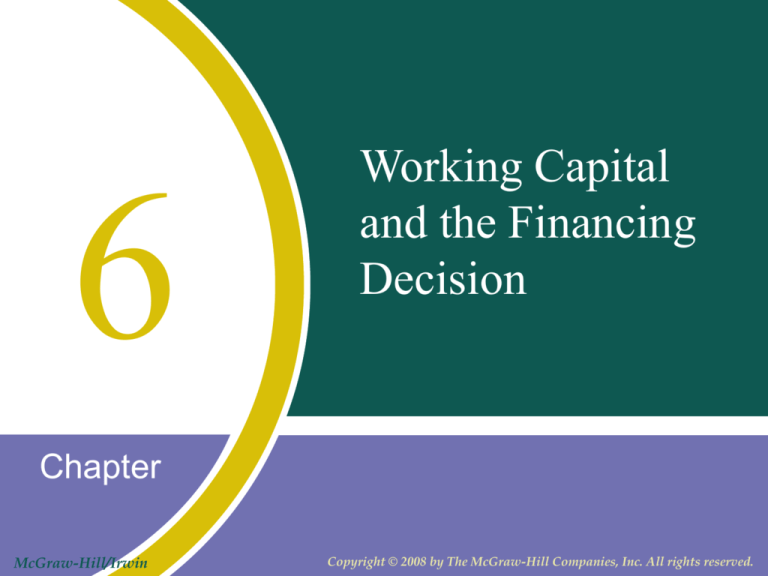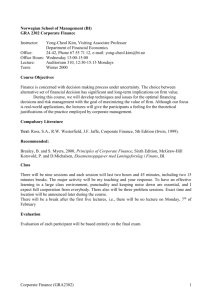
6
Working Capital
and the Financing
Decision
Chapter
McGraw-Hill/Irwin
Copyright © 2008 by The McGraw-Hill Companies, Inc. All rights reserved.
Chapter Outline
•
•
•
•
•
Working capital management.
Current asset management.
Asset financing.
Long-term versus short-term financing.
Risk and profitability vis-à-vis asset
financing.
6-2
Working Capital Management
• The financing and management of the
current assets of a firm.
– Crucial to achieving long-term objectives of the
firm or its failure.
– Requires immediate action.
6-3
The Nature of Asset Growth
• Effective current assets management
requires matching of the forecasted sales
and production schedules.
• Differences in actual sales and forecasted
sales can result in:
– Unexpected buildups.
– Reduction in inventory, affecting receivables and
cash flow.
• Firm’s current assets could be:
– Self-liquidating.
– ‘Permanent’ current assets.
6-4
Controlling Assets – Matching Sales
and Production
• Fixed assets grow slowly with:
– Increase in productive capacity.
– Replacement of old equipment.
• Current assets fluctuate in the short run,
depending on:
– Level of production versus the level of sales.
• When production is higher than sales the inventory
rises.
• When sales are higher than production, inventory
declines and receivables increase.
6-5
Controlling Assets – Matching Sales
and Production (cont’d)
• Cash budgeting process
– Level production method
• Smooth production schedules
• Use of manpower and equipment efficiently to lower
cost
– Match sales and production as closely as
possible in the short run.
• Allows current assets to increase or decrease with
the level of sales.
• Eliminates the large seasonal bulges or sharp
reductions in current assets.
6-6
Temporary Assets under Level
Production – An Example
• Yawakuzi Motorcycle Company
– Sales fluctuations: High sales demand during
early spring and summer; sales drop during
October through March.
– Decision: Apply level production method - 12month sales forecast is issued.
– Result: Level production and seasonal sales
combine to produce fluctuating inventory.
6-7
Yawakuzi Sales Forecast (in units)
6-8
Yawakuzi’s Production Schedule and
Inventory
6-9
Sales Forecasts, Cash Receipts, and
Payments, and Cash Budget
6-10
Sales Forecasts, Cash Receipts, and
Payments, and Cash Budget (cont’d)
• Table 6-3 is created to examine the buildup
in accounts receivable and cash.
– Sales forecast: Based on assumptions taken
earlier (table 6-1).
– Cash receipts: 50% cash collected during the
month of sale and 50% pertains to the prior
month.
– Cash budget: a comparison of cash receipt and
payment schedules to determine cash flow.
6-11
Total Current Assets, First Year
($millions)
6-12
Cash Budget and Assets for II Year
With No Growth in Sales ($millions)
• Graphic presentation of the current asset cycle.
6-13
Patterns of Financing
• Selection of external sources to fund
financial assets is an important decision.
• The appropriate financing pattern:
– Matching of asset buildup and length of
financing pattern.
6-14
Matching Long-Term and ShortTerm Needs
6-15
Long-Term Financing
• Firms can be assured of having adequate
capital at all times:
– Use long-term capital to cover part of the shortterm needs.
– Long-term capital can be used to finance:
• Fixed assets.
• Permanent current assets.
• Part of the temporary current assets.
6-16
Short- Term Financing
• Small businesses do not have total access
to long-term financing.
– They rely on short-term bank and trade credit.
– Advantage: interest rates are lower.
– Short-term finances are used finance:
• Temporary current assets.
• Part of the permanent working capital needs.
6-17
The Financing Decision
• Corporations usually have multiple financial
alternatives to reduce their costs of funds.
– Achieved through the use of a combination of
financing methods.
– Aim to strike a balance between short-term
versus long-term considerations against:
• The composition of the firm’s assets
• The willingness to accept risk.
– Influenced by the term structure of interest rates.
6-18
Alternative Financing Plans
• A Decision Process: Comparing alternative
financing plans for working capital.
6-19
Impact of Financing Plans on
Earnings
6-20
Varying Condition and its Impact
• Tight money periods
– Capital is scarce making short-term financing
difficult to find or may ensue very high rates.
– Inadequate financing may mean loss of sales or
financial embarrassment.
• Expected value
– Represents the sum of the expected outcomes
under both conditions.
6-21
Expected Returns under Different
Economic Conditions
6-22
Expected Returns for High Risk
Firms
6-23
Toward an Optimal Policy
• A firm should:
– Attempt to relate asset liquidity to financing
patterns, and vice versa.
– Decide how it wishes to combine asset liquidity
and financing needs.
• Risk-oriented firm - short-term borrowings
and low degree of liquidity.
• Conservative firm - long-term financing
and high degree of liquidity.
6-24
Asset Liquidity and Financing
Assets
6-25
Toward an Optimal Policy
• Company needs must be met by structuring:
– Working capital position
– The associated risk-return trade-off
• The ultimate concern:
– Maximize the overall valuation of the firm.
– Use astute analysis of risk-return options.
6-26
6-27








